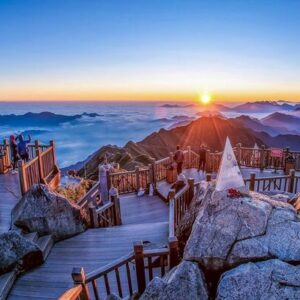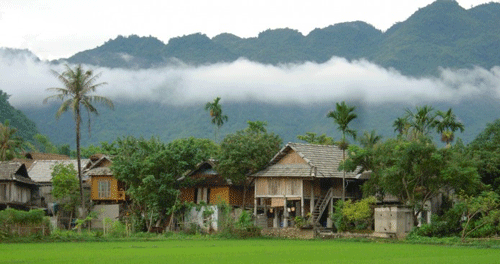On a Vietnam tour, you absolutely must not miss Fansipan. Fansipan is the highest peak in Vietnam, dubbed the “Roof of Indochina,” located in the Hoang Lien Son mountain range, about 9 km southwest of the town of Sapa. It’s an ideal destination for nature enthusiasts, adventure seekers, and those aspiring to conquer the highest peak in their country.
Exploring the summit of Fansipan in Vietnam – A mystical experience on the highest peak of Indochina
General Introduction
Mount Fansipan is situated in the Hoang Lien Son mountain range, approximately 9 km southwest of the town of Sapa, in Lao Cai province, Northwestern Vietnam. Standing at a height of 3,143 meters above sea level, Fansipan’s summit proudly claims the title of the highest mountain in Vietnam and Indochina.
Temperatures at the summit can drop to freezing point, with an average of 4-6 degrees Celsius in winter and 15-20 degrees Celsius in summer. This mountain is also renowned for its diverse ecosystem and rich biodiversity, harboring many rare and precious plant and animal species found only in this region.
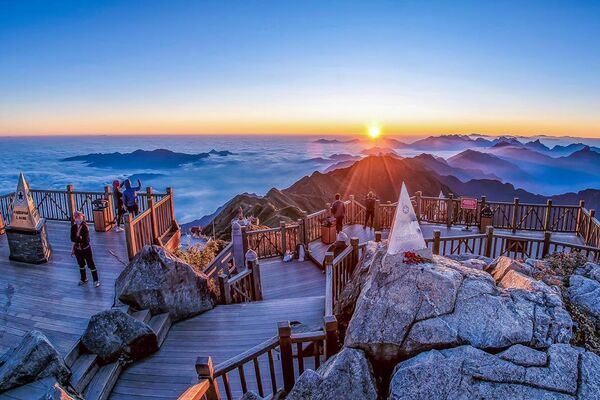
The Fansipan summit in Vietnam
Ideal Period to Visit Fansipan
The summit of Fansipan in Vietnam offers a unique and captivating beauty throughout the year:
- Spring: Fansipan is shrouded in thick mist, creating a mysterious atmosphere. Cherry blossoms and plum trees bloom, adding a charming touch to the surrounding landscape.
- Summer: Climbing roses replace blooming cherry blossoms, coloring fences and roofs along the roads.
- Autumn: Fansipan’s enchanting beauty is accentuated by swirling clouds. From the summit, one can see a magnificent expanse of clouds. Sometimes, the clouds disperse to reveal the dreamy landscape of Sapa.
- Winter: With icy temperatures, Fansipan is covered in a brilliant blanket of snow, particularly captivating when the temperature drops below -9 degrees Celsius.
Thus, depending on your preferences, you can choose the ideal period for your visit.
Ways to Reach the Summit of Fansipan
Hiking
Ideal Period for Hiking
For those who want to discover Vietnam, the most suitable time to climb to the summit of Fansipan is from mid-September to mid-December and from mid-March to mid-May. During these months, the weather is generally cool and dry, with clear skies and good visibility. Trails are also less slippery and easier to traverse during this period.
However, it is important to note that weather conditions at Fansipan can be unpredictable and change rapidly. You should check the weather forecast before starting your hike and prepare for sudden weather changes.
Furthermore, remember that the busiest tourist season in Sapa is from June to August. If you plan to hike during this period, expect a higher influx of tourists and higher accommodation and transportation rates.
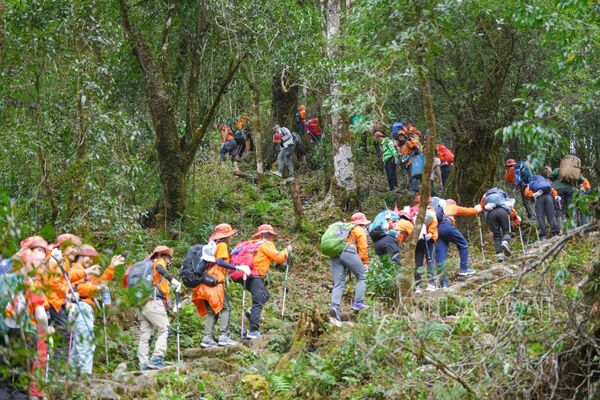
Hiking in Fansipan
Hiking Routes
Vietnam offers several long-distance hiking trails with varying levels of difficulty, from easy to challenging. Here are some recommended hiking routes:
- Tram Ton Pass – Fansipan Summit: This is the most popular route, starting from Tram Ton Pass, about 15 km from the town of Sapa. This trail takes about two days to complete and offers spectacular views of the Hoang Lien Son mountain range and the Muong Hoa Valley.
- Sin Chai – Fansipan Summit: This route begins at Sin Chai, about 4 km from the town of Sapa. It can be completed in about 9 hours by experienced hikers. It is less crowded than the Tram Ton Pass trail, and long-distance hikers can enjoy the tranquility and serenity of the forest.
- Cat Cat Village – Fansipan Summit: This route starts at Cat Cat Village, about 3 km from the town of Sapa. It takes about three days to complete. Although less crowded, it offers magnificent views of the Hoang Lien Son mountain range, the Muong Hoa Valley, and the terraced rice fields.
Hiking Tips
If it’s your first time trekking to the summit of Fansipan in Vietnam, the following tips may be helpful:
- Physical Preparation: Hiking at Fansipan is demanding, requiring good physical fitness. You should exercise regularly for at least a month before your departure.
- Proper Equipment: Make sure to bring appropriate equipment and clothing for your hike, including quality hiking shoes, warm and waterproof clothing. It is also important to bring a backpack, a water bottle, and a flashlight.
- Check the Weather: Check the weather forecast before your departure and prepare accordingly. Mountain weather can be unpredictable, so be prepared for sudden showers and temperature changes.
- Climate Adaptation: Fansipan is located at high altitude, so it is important to spend time acclimatizing before starting your hike. Plan to spend at least one night in Sapa before your departure.
- Local Guide: It is recommended to hire a local guide for your hike. They can provide valuable information about the area, help you navigate, and ensure your safety throughout your journey.
Cable Car
Cable Car Operating Hours
- Departure times for the cable car are as follows: from 08:30 to 17:00 every day, and from 07:30 to 17:30 on Saturdays and Sundays.
- Ticket office opening hours are as follows: from 08:00 to 16:00 every day, and from 07:30 to 16:30 on Saturdays and Sundays.
Getting from the City Center of Sapa to the Cable Car Station
Taxi: The cable car station is located about 3 km from the city center. From the Sapa Stone Church, you can take a taxi, the journey takes about 10 minutes.
On Foot: If you prefer to walk, you can follow the road from the Stone Church passing through the Bac Waterfall Road to the Bac Waterfall crossroad, then turn left onto Nguyen Chi Thanh Road and continue straight to the Fansipan Legend tourist site. Detailed signs are available at this location, allowing you to reach the station without needing to ask for directions.
Muong Hoa Train: A more interesting option is to take the Muong Hoa train, which offers passengers a 6-minute journey through the northwest mountains, from the MGallery Sapa Hotel to the Fansipan Fasipan cable car station. With this train, you can admire the beautiful landscape of the surrounding mountains, including the Muong Hoa Valley, peaceful villages, and terraced rice fields. You can also enjoy the fresh mountain air and the natural beauty of the area. It will be a special experience for a Northern Vietnam tour.
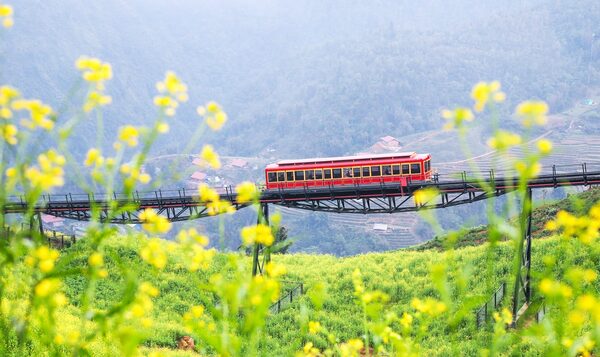
Muong Hoa Train
- Round-trip ticket price: 180,000 VND/person ($7.28), children under 1m are free.
- Operating hours for Muong Hoa Train departures: from 08:15 to 18:00 daily, and from 07:15 to 18:00 on Saturdays and Sundays.
- Ticket office hours: from 08:00 to 16:00 daily, and from 07:30 to 16:30 on Saturdays and Sundays.
Cable Car Ticket Prices:
- Adult ticket: 800,000 VND ($32.4)
- Child ticket (height from 1m to 1.4m): 550,000 VND ($22.27)
- Children under 1m are free.
Notes for Cable Car Ride:
- Bring water, snacks, or preferred food to avoid hunger or thirst, as food and services on the mountain can be quite expensive.
- Avoid carrying too much bulky luggage as the management staff will not allow you to enter the cable car cabin.
- Dress neatly and warmly for hiking and be able to undress easily if you get too hot.
- Whether you depart in the morning or afternoon, don’t forget to bring gloves, a scarf, and a warm hat as the temperature at the top of the mountain is only about 8 degrees Celsius, and there may even be snow in winter.
- Limit solo travel, especially for people with a history of heart problems or high blood pressure.
Do Quyen Train to Fansipan Summit:
The train will depart from Fansipan Station in Vietnam, which is also the same as the cable car station, so you can consider transportation methods to get to this station.
The train will not take you directly to the summit of Fansipan; you will need to climb about 600 additional steps, which will take about 20 to 30 minutes. The train experience will allow you to visit Ha and Thuong Temples and admire the Do Quyen Flower Road along the way.
Opening Hours:
- Operating hours for train departures are as follows: from 08:30 to 17:00 daily, and from 07:30 to 17:30 on Saturdays and Sundays.
- Ticket office hours: from 08:00 to 16:00 daily, and from 07:30 to 16:30 on Saturdays and Sundays.
Train Ticket Prices:
- Single round-trip ticket: 150,000 VND/person ($6.07). You can purchase tickets for each individual trip or a round-trip ticket.
- Children under 1m are free.
Notes for Mountain Train Ride:
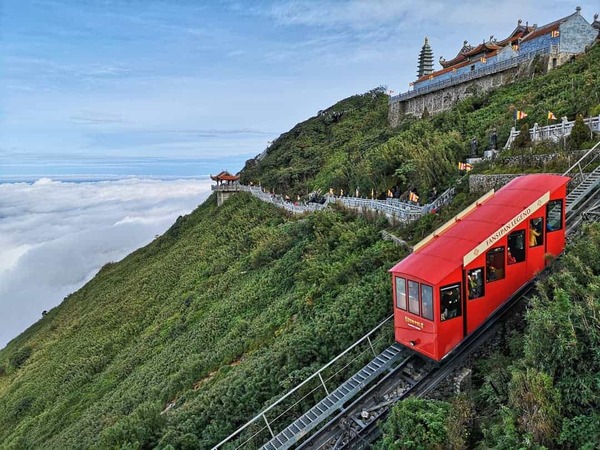
Do Quyen Train
- Given that the train does not take you all the way to the summit of Fansipan and you have to climb a number of steps, you should consider your health.
- Due to the nature of the train and the terrain, both the ascent and descent can cause nausea. Therefore, it is advisable to consider if you are prone to motion sickness.
Attractions of Fansipan in Vietnam
The Roof of Indochina
The summit of Fansipan is located in the Hoang Lien Son mountain range, the highest mountain range in the system of three countries of Vietnam, Laos, and Cambodia, earning it the nickname “Roof of Indochina”. Its local name is Hua Xi Pan, meaning “giant rock” standing above the clouds, at an altitude of 3,143 meters. Fansipan has a lifespan of about 260 to 250 million years and its height increases by 0.32 meters each year, making it a must-visit destination on your trip to Sapa.
It is called Hoang Lien Son because this mountain range is home to a rare and precious medicinal plant called Hoang Lien. In addition to that, the Hoang Lien Son mountains are also the “cradle” of precious wood – Dalbergia wood; various animal species such as pheasants, bears, monkeys, saola, and thousands of species of medicinal plants. Explore Hoang Lien Son National Park with its 136 bird species, 56 animal species, and 553 insect species. The ecosystem of Fansipan is highly diversified, with about 1,680 tree species distributed in 679 genera belonging to 7 groups, some of which are rare and precious.
Majestic Beauty
From the summit of Fansipan, you can admire a diverse and rich landscape. Under the morning or evening light, on one side stand the endless green mountains, each mountain range stretching like strips of soft fabric. On the other side, you will find the depth of valleys and lakes, where thick mist creeps in, creating a mysterious and mystical landscape.
Moreover, from the summit of Fansipan, you can clearly see neighboring mountains such as Mount Lu Quan, Mount Hon Bo, and especially the renowned Muong Hoa Valley, with its sparkling terraced rice fields under the setting sun and its modest fishing villages along the river.
As for fauna, although living conditions at the summit of Fansipan are extremely difficult, life there is still flourishing. You may encounter rare bird species such as the White-backed Woodpecker, the Indochinese Pheasant, and even the wild chicken species, the Indochinese Pheasant. Additionally, if you’re lucky, you may spot animals such as the goat, the Indochinese deer, or the Hoang Lien Son wildcat, contributing to the unique biodiversity at the summit of Fansipan.
Year-round Cool Climate
Fansipan, with its 3,143 meters altitude, is not only the highest peak in Vietnam but also a place with a cool climate all year round, which is quite astonishing. At this altitude, the climate at the summit of Fansipan is not directly influenced by the sea, creating a fairly stable and cool climate environment.
In summer, although the sun still shines, it’s not too hot thanks to the altitude and the coolness of the wind from the surrounding mountains. In winter, when the temperature can drop below 0 degrees Celsius, accompanied by the cold from the north, it creates a white snowy landscape, bringing a calm and peaceful atmosphere.
Thanks to its year-round cool climate, Fansipan not only attracts challenge enthusiasts with its climb but also tourists seeking relaxation and discovery of wild natural beauty. This is one of the reasons why Fansipan is an attractive destination not only for Vietnamese but also for international tourists.
Temple Complex
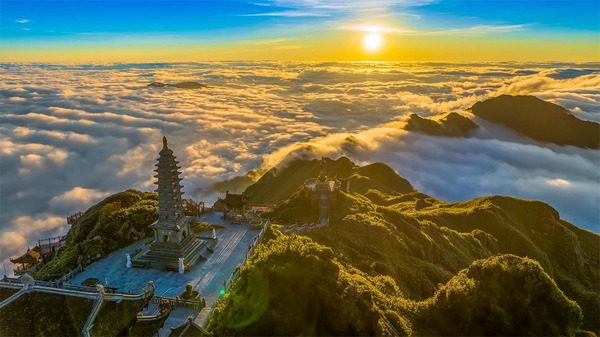
Cluster of temples at the top of Fansipan in Vietnam
Another must-visit place when you are at Fansipan is the spiritual complex called Kim Son Bao Thang Tu. From afar, this sacred site resembles an ancient temple perched atop the mountain, blending into the green of the forest, creating a magnificent view.
The Great Hall of the Emperor is situated at the center of Kim Son Bao Thang Tu, where many Buddhas sculpted by famous artisans are gathered. The decoration style of the statues here follows the rules of Northern Zen Buddhism. Besides the impressive spiritual architecture, the Great Statue of Buddha Amitābha, standing at 13.5 meters tall, seated on a lotus, cast from thousands of thick copper plates and pressed onto an imposing steel structure.
In conclusion of this tourist guide to the summit of Fansipan, we hope that the information and experiences we have shared have given our valuable readers a broader and deeper insight into this destination.
Fansipan is not just a mountain but also an extraordinary experience of the beauty of nature and the marvels of Vietnam. Exploring the majestic landscapes, encountering biodiversity, and breathing the fresh air at the summit of Fansipan are unforgettable experiences. Fansipan is definitely the right destination for those seeking a Vietnam’s green tour.
Learn more: Mai Chau: Meet the northwest masterpiece of Vietnam

